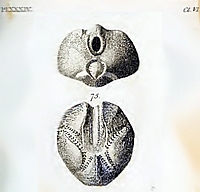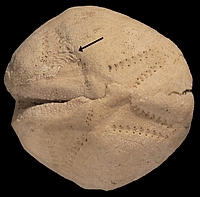Echinocardiidae
Wythe Cooke 1942, p.59
Genre type : Echinocardium Gray, 1825
Description succincte de la famille : système apical ethmolytique. Fasciole interne et subanal. Plaques épisternales amincies en arrière, sternales paires et symétriques. Labre court, en contact avec la seconde plaque ambulacraire.

|
Echinocardium, Van Phel.? Body cordiforme ; back equal, tuberculated ; ambulacra five, the posterior one in a groove, perforated. E. atropos. Spatangus, Lam. E. pusillus, Leske, t. 38, f. 5 ; Klein, t. 24, f. c d e. E. seba, Seba, iii. t. 10, f. 21, A B. |
![]()
|
2. Echinocardium cordatum.
Tlii.s large .series of specimens does not reveal any satisfactory way of separating E. australe from E. cordatum. There is no constant diflference between specimens of the same size from England, Japan, South Africa, and Australia. It is true that in the Far East and .South E. cordatum does not seem to reach nearly so large a size as it does in European seas ; the largest extra-European specimen is from Kobe ; this measures 44x42x30 mm. European examples reach twice this size inifler favourable conditions ; one from the Scilly Islands measures 73 x63 x40 mm., one from Ballynakill 80 x 70 x40, and one in a wall case in the Exhibition Gallery. from Moyard, Galway, about 90 x 80 mm. |
|
Echinocardium cordatum (Pennant,1777) - Actuel, France. Bretagne. St. Michel, en grève. spécimen récolté mort après une tempête, 49 mm |
![]()
|
Echinocardium marylandiense, new species Figure 6; Plate 7: figures 2, 3; Plate 8: Figures 1, 2 Echinocardium orthonotum.—Clark, 1904:430, pl. 119: figs. 1 a-c—Clark and Twitchell, 1915: pl. 98: figs. 1 a-c, 2ac— Schoonover, 1941:92-93.—Cooke, 1942:60 [the specimens from Maryland belong to this species].—Vokes, 1957: 39, pl. 30: figs. 1-3.—Cooke, 1959: pl. 33: figs. 1-5. Diagnosis.—Species characterized by petals expanding adapically, with outer poriferous zones of an anterior petal forming almost continuous arc with those of posterior petal; wide test with width equal to length, height 54-69 percent L, central apical system, width of area circumscribed by internal fasciole 37-44 percent L, prominent nodes on interambulacral plates. Material.—Hundreds of specimens of this species have been found, particularly near Scientists' Cliffs, Calvert County, Maryland. Large slabs from there are filled with specimens (Schoonover, 1941). The description here is based on specimens from this locality, and the statistics were taken from 15 individuals. Shape and size.—Largest specimen 57.0 mm long, smallest 43.5, mean 47.4 (SD 4.1, CV 8.7, N-15) ; test wide, nearly as wide as long with width 94-104 percent L, mean 97.9 (SD 3.0, CV 3.1, N - 1 5 ) , greatest width anterior of center; test high with height 54—69 percent L, mean 59.0 (SD 4.4, CV 7.4, N-14), greatest height posterior of apical system; posterior truncation oblique with periproct slightly visible from above. Apical system.—Four genital pores, ethmolytic with genital 2 extending far posteriorly; located at distance from anterior margin to center of genital pores equal to 40-51 percent L, mean 46.4 (SD 2.9, CV 6.2, N - 1 5 ). Ambulacra.—Anterior ambulacrum not petaloid (Plate 7: figure 2), in groove from apical system to peristome, at margin depth of groove equal to 3.9 percent L (SD 0.8, CV 20.3, N-14) ; porepairs within internal fasciole oblique with adapical pore of pair larger than adoral, small node between pores of each pair; pores in plates between internal fasciole and phyllode very small, single or slit-like; 7 pores in single poriferous zone from internal fasciole to peristome. Anterior paired petals very wide with large porepairs outside of internal fasciole and 3-5 large porepairs within internal fasciole in posterior poriferous zone, none in anterior poriferous zones within internal fasciole, petals only slightly depressed, narrowing distally; 9-11 (mean 9.7) large porepairs outside of internal fasciole in petal IIa, 5-8 (mean 6.4) large porepairs outside of internal fasciole in petal IIb. Posterior paired petals with no large porepairs within internal fasciole, 9-11 (mean 9.8) large porepairs in petal Va outside of internal fasciole, 8-10 (mean 8.8) in petal Vb outside of internal fasciole; outer poriferous zones of anterior and posterior petals forming almost continuous arc; ambulacral plates beyond petals with single pores except within anal fasciole, where 2 porepairs are in each single poriferous zine. Interambulacra.—A single prominent node on each interambulacral plate; 22-24 plates in interambulacrum 5, 15-17 in interambulacrum 1, 10-11 in 2 from internal fasciole to peristome. Peristome.—Located at distance from anterior margin to anterior edge of peristome equal to 28-34 percent L, mean 31.6 (SD 1.5, CV 4.8, N-15) ; opening wider than high with width 21-25 percent L, mean 21-25 (SD 1.1, CV 4.8, N-14). Periprocte.-—Located high on posterior truncation, opening slightly higher than wide with height 10-16 percent L, mean 12.6 (SD 1.6, CV 12.6, N-12), width 11-14 percent L, mean 12.8 (SD 0.9, CV 7.0, N—13) ; located between plates 5-8. Oral plate arrangement.—Labrum wide (Figure 6), extending across almost entire width of peristome, extending posteriorly two-thirds height of first ambulacral plate; length of labrum 7-11 percent L, mean 9.1 (SD 0.8, CV 9.1, N-15) ; plastron extending to posterior margin, length 50-55 percent L, mean 52.0 (SD 1.8, CV 3.4, N-15) width 33-36 percent L, mean 34.8 (SD 1.1, CV 3.1, N-15) ; first plate of interambulacra 1,4 very narrow. Ambulacra widening near peristome (Figure 6), phyllodes with 5 pores in ambulacrum III, 7-8 in II, 6 in I. Fascioles.—Internal fasciole prominent, greatest width of tract 2.9 mm in specimen 48 mm long or 6.0 percent L, fasciole crossing ambulacral plates 7a and
|
7b in ambulacrum III, 20a and 17b in ambulacrum II, 21a and 23b in ambulacrum I, lla-12a or b in interambulacrum 5, 9a-10a or b in 1, 7a or 7b in 2; greatest width of area circumscribed by internal fasciole anterior of apical system, width 37^-4 percent L, mean 39.1 (SD 2.1, CV 5.5, N-14). Subanal fasciole occurring on posterior truncation below periproct, area circumscribed by fasciole 14.4 mm wide on specimen 45 mm long or 32 percent L, maximum width of tract 1.7 mm wide on specimen 45 mm long or 3.7 percent L; crossing plates 3-5 of interambulacrum 5, plates 6a-8a of ambulacrum I, plates 6b-8b of ambulacrum V. Anal fasciole present but tract not clear. Comparison with other species.—Echinocardium marylandiense differs from E. orthonotum from the Upper Miocene Yorktown Formation of Virginia and Upper Miocene of South Carolina in having a wider, more angular, and higher test, a wider, more posteriorly situated peristome, a narrower periproct, shorter, wider plastron, longer labrum, wider fascioles, and a wider area curcumscribed by the internal fasciole, and more prominent nodes on the interambulacral plates. See Table 1 for the statistical expression of these differences. Of all the living species, E. marylandiense most resembles E. cordatum (Pennant). It differs in the following characters: 1. Lower test lacking the greatly inflated area posterior to the apical system. 2. Apical system centered, whereas in E. cordatum it is posteriorly very eccentric. 3. Wider area circumscribed by internal fasciole. 4. Anterior poriferous zones more anteriorly situated. 5. Larger pores in posterior poriferous zones of anterior petals within internal fasciole; in E. cordatum these pores are microscopic, whereas in E. marylandiense they are distinguished easily with the naked eye. 6. Posterior truncation tilting in E. marylandiense so diat periproct is almost visible from above, whereas in E. cordatum the truncation is vertical to overhanging. 7. Area circumscribed by subanal fasciole much wider, widi width greater than height, whereas in E. cordatum it is much narrower, with width less than height. 8. Plastron less inflated and labrum with longer posterior extension. 9. Anterior ambulacrum much less depressed from apical system to margin. Type-specimens.—Holotype: USNM 174460; figured specimens: USNM 174467, 498960a,b, 559489. Stratigraphic position and geographic localities.— Middle Miocene Choptank Formation, typespecimens and measured specimens came from slabs (Schoonover, 1941) collected 2200 feet N of stairway and artesian well at Scientists' Cliffs, which in turn is 1.5 miles N of Kenwood Beach ( = Governor's Run), and about 1 mile S of mouth of Parker Creek, Calvert County, Maryland. The slabs were found 18 feet above mean high tide within a vertical range of three or four inches, which extends about 12 feet along face of cliff. The slabs consist mainly of quartz sand and come from a horizon near the contact between the Calvert and Choptank Formations and 18 feet below the bottom of Shattuck's (1904) Zone 17 of the Choptank, according to Schoonover (1941). T. G. Gibson of the United States Geological Survey has studied the Foraminifera in one echinoid from these slabs and states (personal communication, 1971) that the assemblage is typical of the Choptank Formation in this area. Other localities: Jones Wharf, Patuxent River, Maryland, and specimens provisionally referred to this species from Grubin Neck, 1 mile N of Howell Point, Talbot County, Maryland. Planches 7 et 8 (extraits) |
|
Echinocardium marylandiense Kier,1972 - Miocène, Choptank Fm, Calvert Beach Membert (bed 16), Scientist's Cliff, Calvert County, Maryland, U.S.A., 47 mm |
![]()
|
E. mediterraneaum Forbes. Fig. 94. - Voir Agassiz. 1872-74, p. 580, pl. XXV, fig. 29 ; Koehler, 1883, p. 132 et 1898, p. 175, pl. IV, fig. 1-3 ; Mortensen, 1907, p. 150. Le test, à peu près aussi long que large, n'atteint jamais de grandes dimensions ; les échant. ont 3,5 cm. de long., exceptionn. 4 cm. Le contour vu d'en haut est anguleux avec une dépression ant. peu important, et la rég. post. est rétrécie. Les faces dors. et ventr. sont aplaties et l'extrém. post. forme une gibbosité assez marquée ; les faces ant. et post. sont vertic. L'E. mediterraneum est surtout caractérisé par la forme du sillon ant. dors. qui n'existe qu'en avant du fasc. int. et se trouve exactement localisé sur la face ant. vertic. du test ; ce sillon est d'ailleurs peu profond et étroit, et il offre sur sont bord des tuberc. à peine plus gros que les voisins. Le fasc. int. est plutôt court, puisqu'il s'arrête au début du sillon ant. du test et il reste assez étroit ; en dedans de ce fasc. se montrent plusieurs tuberc. assez développés. Le reste de la face dors. est uniform. couvert de petits tuberc., mais ceux de la face ventr. sont plus développés. Le péripr. est allongé vertic., étroit, 2 fois plus haut que large. Le fasc. sous-anal renferme une ou 2 p. de pores de chaque côté et le labre atteint la 2e pl. ambul. voisine. Les piq. de la face dors. sont fins, serrés, appliqués et même feutrés ; sur la face ventr., ils sont beaucoup plus |
gros, plus longs et souvent
recourbés ; les piq. sternaux sont spatulés. Les
pédic. sont de 4 sortes comme chez l'E. cordatum car il
n'existe par d'ophic. ; les globif. ont les valves plus allongées que
chez ce dernier. L'E. mediterraneaum est surtout connu en Méditerranée où il n'est d'ailleurs pas très commun. Je l'ai rencontré sur les plages de Foz (Bouches-du-Rhône) et de Saint-Raphaël (Var) où il vit à une faible prof. ; il est connu à Nice, sur nos côtes d'Algérie, à Naples, etc. Dans l'Atlantique il n'a encore été recueilli qu'au cap Sagres par la "Princesse Alice". Fig. 94, extrait |
|
Echinocardium mediterraneum (Forbes, 1844) - Lower Coralline Limestone, basal level (Scutella bad), Dwejra bay, Gozo, Malte, 18 mm |
|
Echinocardium mediterraneum (Forbes, 1844) - Miocène, Sessimbra, Portugal, 30 mm |






,%20periprocte,%20Lower%20Coralline%20Limestone,%20basal%20level%20(Scutella%20Bed),%20Dwejra%20bay,%20Gozo,%20Malte,%2018%20mm.jpg)